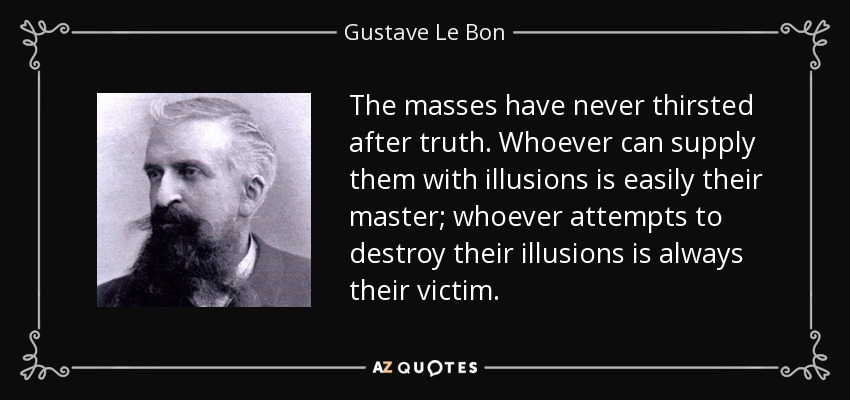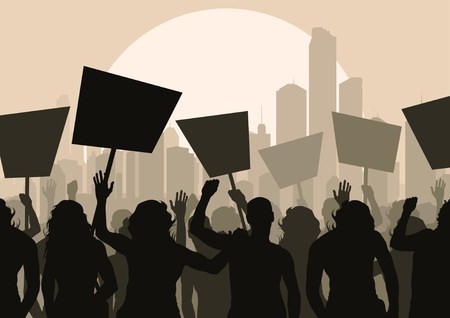Exhibit 1: Gustav Le Bon, 1896, The Crowd, Full Audiobook
Policy makers, like most people, normally feel that they already know all the psychology and all the sociology they are likely to need for their decisions. I don't think they are right, but that's the way it is.
Collective Behavior, Social Movements, and Mass Publics
by
Charles Lamson
Social Movement Theory
Early theories of collective behavior were derived from the notion that hysteria or contagious feelings such as hatred or fear could spread through masses of people. One of the first social thinkers to develop a "mass contagion" theory of collective behavior was Gustave Le Bon (below Image 1) An aristocratic critic of the emerging industrial democracies, Le Bon believed that those societies were producing "an era of crowds" in which agitators and despots are heroes, "the populace is sovereign, and the tide of barbarism mounts" (1947/1896, The Crowd, pp. 14, 207, full audiobook above Exhibit 1). In its usual definition, he pointed out, "the word 'crowd' means a gathering of individuals of whatever nationality, profession, or sex, and whatever be the chances that have brought them together." But from a psychological viewpoint a crowd can create conditions in which "the sentiments and ideas of all the persons in the gathering take one and the same direction, and their conscious personality vanishes."
 |
IMAGE 1 Gustave Le Bon
Le Bon attributed the strikes and riots that are common in rapidly urbanizing societies to the fact that people are cut off from traditional village social institutions and jammed into cities, creating a mass of strangers. This view of early industrial societies was clearly exaggerated; research has shown that urban newcomers seek to form new social attachments, often drawing on the networks of people who come to the city from the same rural area or small town. But more important, research on crowds and riots has shown that despite the appearance of a mob mentality and psychological contagion, people who participate in riots, demonstrations, and other forms of collective behavior actually have many different motivating emotions and may only appear to be following along blindly as if they were part of a herd. Also, the contagion theories of La Bon and others are not useful in understanding the full range of collective behavior and social movements that arise from the strains and conflicts characteristic of rapidly changing industrial societies (Rochon, 1998, Culture Moves: Ideas, Activism, and Changing Values).
A Continuum of Collective Behavior
Collective behaviors and social movements can be placed along a continuum according to how much they change the societies in which they occur. At one end of the continuum are revolutions; at the other are fads or crazes. In the twentieth century three major revolutions occurred: the communist revolutions in Russia and China and the fascist revolution that brought Hitler to power in 1933. These can be placed at the high end of the continuum. At the low end are fads and crazes that may excite us for a while but usually do not bring about lasting change in the major structures of society (Turner, 1974, The Theme of Contemporary Social Movements. In R. E. L. Faris, Ed., Handbook of Modern Sociology). Some people become so completely involved in a fad or craze that they devote all their energies into the new activity.
Between the two extremes of revolutions and fads are social movements that capture the attention of masses of people and have varying effects on the societies in which they occur. The women's movement, the civil rights movement, and the environmental protection movement are examples of movements with broad membership in many nations and the continuing power to bring about social change. The gay liberation movement, the anti-abortion movement, the Evangelical movement, and the hospice movement are examples of more narrowly focused movements that are concerned with a single issue or set of issues but also exert powerful pressure for change in the United States and other societies.
Theories of collective behavior and social movements often seek to explain the origins and effects of revolutionary and reform movements (Kimmel, 1990, Revolution: A Sociological Interpretation; McAdam, McCarthy, & Zald, 1988, Social Movements. In N. J. Smelzer, Ed., The Handbook of Sociology). In the remainder of this section we discuss several such theories. We begin by examining the nature of revolutions and revolutionary movements. Then we consider theories that attempt to explain why major revolutions and revolutionary social movements have arisen and what factors have enabled them to succeed. Note that these are macro-level theories: They explain revolutions and associated social movements as symptoms of even larger-scale social change.
Theories of Revolution
Sociologists often distinguish between "long revolutions," or large-scale changes in the ecological relationships of humans to the earth and to one another (e.g., the rise of capitalism and the Industrial Revolution), and revolutions that are primarily social or political in nature (Braudel, 1984, The Perspective of the World: Vol. 3: Civilizations and Capitalism: 15th-18th Century; Wolf, 1984a, November 4, The Perspective of the World. New York Times Book Review, pp. 13-14; 1984b, November 4, Unifying the Vision. New York Times Book Review, p. 11). The course of world history is shaped by long revolutions, whereas individual societies are transformed by social revolutions like those that occurred in the United States, France, and Russia (Bobrick, 1997, Angel in the Whirlwind: The Triumph of the American Revolution).
Political and Social Revolutions In States and Social Revolutions, sociologist Theta Skocpol (1979) makes a further distinction between political and social revolutions. Political revolutions are transformations in the political structures and leadership of a society that are not accompanied by a full-scale rearrangement of the society's productive capacities, culture, and stratification system. Social revolutions, on the other hand, sweep away the old order. They not only change the institutions of government but also bring about basic changes in social stratification. Both political and social revolutions are brought about by revolutionary social movements as well as by external forces like colonialism.

IMAGE 3 The Battle of Concord
The American Revolution, according to Skocpol's theory, was a political revolution. The minutemen who fought against British troops at the Battle of Concord (see Image 3) were a political revolutionary group that did not at first seek to change American society in radical ways. On the other hand, the revolutions that destroyed the existing social order in Russia and China in the 20th century were social revolutions. Their goal was to transform the class structure and institutions of their societies.
Skocpol's analysis further shows that the actual outcomes of social revolutions depend on the kinds of coalitions formed among revolutionary parties and larger social classes. The Communist revolutionaries in Russia, for example, did not join forces with the peasants as the Chinese communist revolutionaries did. One consequence was that in the former Soviet Union the peasants were persecuted during the revolution; their land was taken from them, and many were forced to live on collective farms. These disruptions of the society's agrarian base severely weakened the economy. In China, however, while there were many disruptions of rural life after the communists took power, food production continued to be carried out in villages and small land holdings. Peasant communist leaders replaced feudal landowners, but agricultural production did not suffer as it did in the former Soviet Union.
Why do revolutionary social movements arise, and what makes some of them content mainly with seizing power while others call for a complete reorganization of society? For most of the century the answer has been some version of Marxian conflict theory. This theory uses detailed knowledge of existing societies to predict the shape of future ones. According to Marx, the world would become capitalist; then capital markets would come under the control of monopolies; impoverished workers and colonial peoples would rebel in a generation of mass social movements and revolutions; and a new, classless society would be created in which the workers would own the means of production (Marx, 1962/1867, Capital: A Critique of Political Economy).
Relative Deprivation The idea that the increasing misery of the working class would lead workers to join revolutionary social movements was not Marx's only explanation of the causes of revolution. He also believed that under some conditions, "although the enjoyments of the workers have risen," their level of dissatisfaction could rise even faster because of the much greater increase in the "enjoyment of the capitalists, which are inaccessible to the worker" (Marx & Engels, 1955, Selected Works in Two Volumes, p. 94). This is a version of the theory known as relative deprivation (Stouffer et al., 1949, Studies in Social Psychology in World War II: Vol. 1. The American Soldier: Adjustment During Army Life). According to this theory, the presence of deprivation (i.e., poverty or misery) alone does not explain why people join revolutionary social movements. Instead, it is the feeling of deprivation relative to others. We tend to measure our own well-being against that of others, and even if we are doing fairly well, if they are doing better we are likely to feel a sense of injustice and sometimes, extreme anger. This feeling of deprivation relative to others may result in revolutionary social movements.

IMAGE 4 French Revolution Propaganda Poster
Alexis de Tocqueville came to the same conclusion in his study of the causes and results of the French Revolution. He was struck by the fact that the revolution did not occur in the 17th century, when the economic conditions of the French people were in severe decline. Instead, it occurred in the eighteenth century, a period of rapid economic growth. Further, Tocqueville concluded that "revolutions are not always brought about by a gradual decline from bad to worse. Nations that have endured patiently and almost unconsciously the most overwhelming depression often burst into rebellion against the yolk the moment it begins to grow lighter" (1955/1856, The Old Regime and the French Revolution, p. 214).
Revolutions are most likely to occur when a period of improvement and economic and social conditions is followed by a sudden reversal. When expectations are rising, people do not generally rebel, either through outbreaks of mob action or through organized social movements. But when their situation begins to improve and their expectations continue to rise as well, the extent to which their expectations are actually satisfied takes a sharp downturn. Then the conditions for rebellion are enhanced. At some point the affected population can no longer tolerate the gap between what it expects and what it is getting, and rebellion breaks out.
Clearly, the theory of relative deprivation can help us identify the conditions that lead us to collective behavior (see Image 5). However it cannot tell us when the gap between expectations and reality will become intolerable or what kinds of collective behavior will actually occur. To know those things, we must be far closer to the actual situation and be skilled at observing and interpreting it.
IMAGE 5 Collective Behavior

Valuable as they are as broad theories of revolution, neither Marxian theory nor Tocqueville's analysis can fully explain the rise of revolutionary movements throughout the contemporary world, nor did they help much in understanding the changes major social movements go through as their goals and organizations evolve. These and related questions are analyzed more directly in recent theories of protest cycles and changes within social movements to which we now turn in the next post.
*MAIN SOURCE: SOCIOLOGY IN A CHANGING WORLD, 6TH ED., 2003, WILLIAM KORNBLUM, PP. 221-223*
end
|

No comments:
Post a Comment